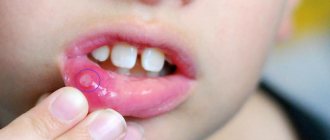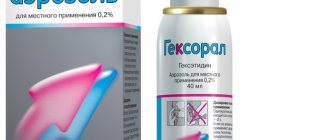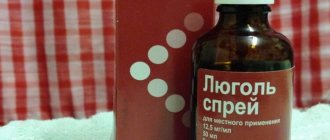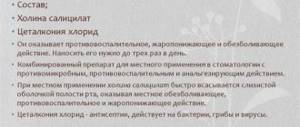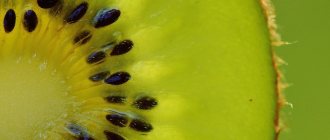Blue or methylene blue solution is an antiseptic for external use. Used to treat fungal, bacterial, and herpetic stomatitis. Indicated for use by persons over one year of age. With regular use, it allows you to achieve a lasting therapeutic effect in 3-5 days. In this material we will understand what blue is, what the active components of this product are, their properties, indications and contraindications for the use of the drug, features of its use in different age groups, possible side effects, as well as analogues on the market.
Pharmacokinetics of the substance
The main effect that blueing has is disinfection and restoration of an acidic environment; it perfectly conducts hydrogen ions in tissues, due to which it is periodically used as an antidote for poisoning.
In cases of local exposure, blue is not able to enter the bloodstream, therefore it is considered a safe medical product. Even if swallowed, there may be no side effects; it is eliminated through the excretory system.
Methylene blue, which enters the body through injection, is eliminated through the renal system.
Description
The drug is widely used to suppress any fungal, viral and bacterial infection that develops in the oral cavity. The main component of the drug is methylthionine chloride. The auxiliary ingredient is ultra-purified water. When treating stomatitis, a 1% aqueous solution should be used. It can be purchased at a pharmacy. Release form: bottles with a capacity of 25, 50, 100 ml.
The antiseptic methylthionine chloride is a liquid colored bright blue. The main substance, methylene, is capable of quickly penetrating into tissues, staining them upon slight contact. Therefore, it is recommended to wear gloves before handling.
The action of blue is based on its ability to bind bacterial cells, thereby neutralizing pathogenic microorganisms. In this case, aqueous methylene does not penetrate into the systemic circulation.
The drug should be stored in a closed bottle and a dark place, away from children. It is prohibited to use the product after its expiration date.
Methylene Blue Price
Prescription pharmacies prepare a solution of methylene blue. The drug is very cheap, so you don’t have to look for promotions and sales. The price of one such ready-made bottle with a 1% aqueous solution in Moscow and St. Petersburg is 28-60 rubles for a volume of 25 ml. You can even buy blue powder. Some online stores sell this substance. It’s also not that expensive - the price per kilogram is about 6,000 rubles, but you need very little. Delivery of your purchase can be ordered in any convenient way - by mail or courier.
Side effects
If you carefully follow medical recommendations and follow the instructions, blueing most likely will not cause harm to your health.
But the following adverse reactions were observed in some patients:
- Nausea and vomiting;
- Abdominal pain;
- Burns of mucous membranes;
- Allergic skin rashes.
Symptoms of the disease
Stoma is a word with Greek roots that means “mouth.” The following symptoms are characteristic of stomatitis:
- Swelling of the mucous membrane.
- Formation of white or yellow plaque.
- An increase in temperature is quite difficult to bring down with drug treatment.
- Bleeding gums.
- Bad breath.
If stomatitis is a single manifestation, it will most likely recede on its own - this will take about a week. However, if you have doubts, it is better to see your doctor, especially if the child has symptoms of stomatitis.
The use of blue in children
Dentists often prescribe blue for stomatitis in children, since this solution leads to a significant improvement in the condition already on the third day of use.
After one year of age, it is recommended to treat the breast or pacifier that the baby puts in his mouth. Sanitation is carried out up to 3 times a day.
From one to six years, the procedure is identical to adult treatment: remove plaque, blot off excess moisture, treat ulcers with methylene blue. Repeat up to 5 times a day along with additional therapy.
Note!
Metrogyl denta - analogues, advantages of use, composition features and indications for use- Bathroom vanity unit - choose the best option. Photo of design, combination, sizes, color
Periodontocide - means for prevention, release form, methods of application and indications for use
After age six, a healthcare professional may prescribe rinsing up to 10-12 times per day.
conclusions
- Blue is an antiseptic whose main active ingredient is methylthioninium chloride.
- The drug is used in dentistry to treat bacterial, fungal, and herpetic stomatitis.
- The main contraindications to its use are hypersensitivity to the drug, pregnancy, and the patient’s young age.
- To treat the mucous membrane, use an aqueous solution of blue. They treat the affected areas of the mouth, as well as nearby tissues. The product is also used to rinse the mouth.
- The course of treatment with blue is from 5 to 10 days. The exact duration of treatment is determined by the doctor, taking into account the patient’s condition, the type of stomatitis, as well as the presence of concomitant diseases. Rinsing can be combined with cauterization of problem areas. Read more details about how to cauterize stomatitis here.
How to make a solution from powder
Pharmacies sell a ready-to-use 1% blue solution. The powdered substance lasts longer, so if this is the only option available, there are two ways to make a blue solution for stomatitis. You can order the solution from a pharmacist or mix it yourself. The shelf life of the diluted powder is 14 days.
Dilute 10 grams of powder in 1 liter of boiled water until the crystals are completely dissolved.
Strain the resulting solution through a fine sieve or cheesecloth in several layers (at least 6).
Now you know how to properly use bluing for stomatitis. Take care of your health and be fully armed!
Analogs
If for some reason the drug is not suitable for the patient, it can be replaced with analogues. These are:
- Hydroperite. Tablets for preparing an antiseptic solution. Used to rinse the mouth for stomatitis;
- Potassium permanganate. Antiseptic for treating mucous membranes;
- Myristamide. A colorless antiseptic liquid that destroys microorganisms. Used for various forms of stomatitis;
- Sodium tetraborate. Transparent disinfectant liquid used in dentistry, gynecology, surgery.
You should not replace one drug with another on your own. If you decide to use a bluing substitute, be sure to contact the doctor who prescribed this medication and discuss the replacement with your doctor.
Photo of blue from stomatitis

1
Join the discussion of the article:
Arthur
I used to suffer from stomatitis very often... a terribly unpleasant little thing... I even had several ulcers in my mouth at the same time and some even bled a little, it was painful to talk in this case. Blue helps, I also used alum, it’s a white powder, but it’s easier to smear it with blue than to use the powder to pour it in and not manage to swallow it right away
